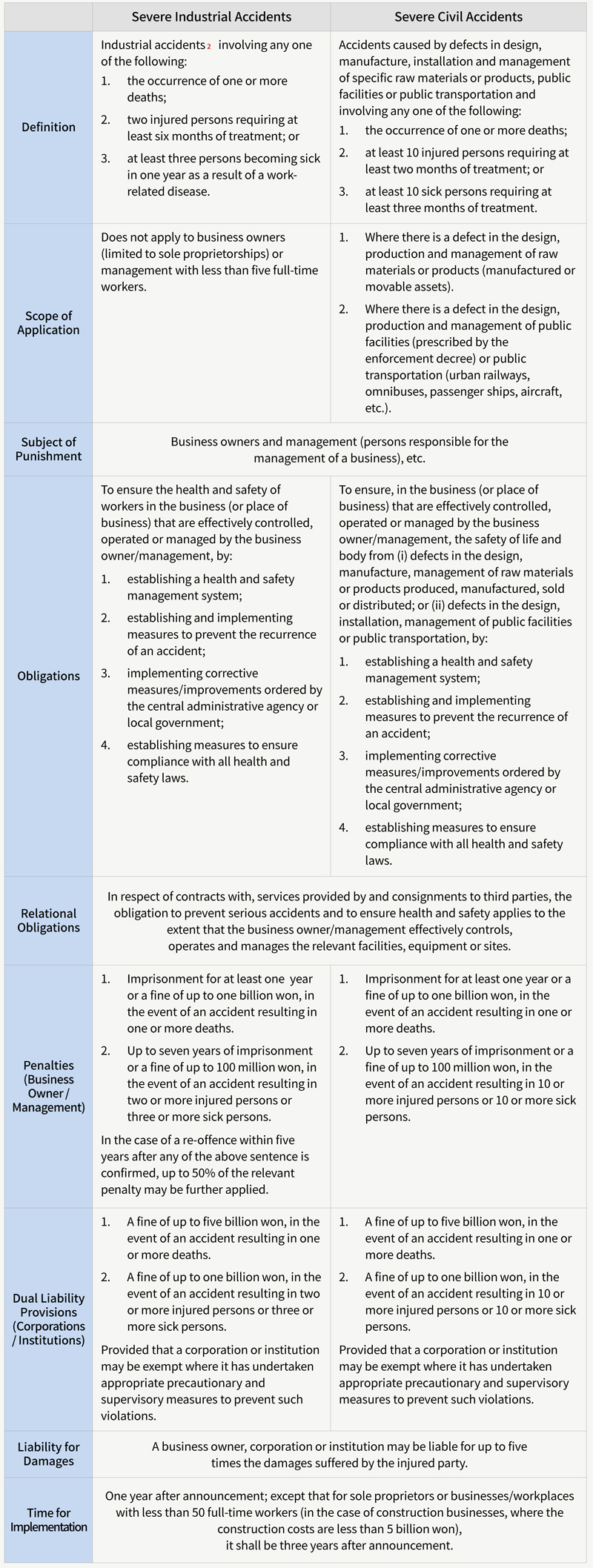1. Introduction
The new Severe Accidents Punishment Act1 (the “Act”) was passed (as originally proposed by the Judiciary Committee) at the plenary session of the National Assembly on January 8, 2021. The final version of the Act has attracted a lot of attention from both business and labor sectors, just as the bill had when it was first proposed. The Act classifies “severe accidents” into “severe industrial accidents” and “severe civil accidents”. The key features of these classifications are summarized in the table below.

2. Commentary
A. Management
Under the Act, “management” or “persons responsible for the management of a business” is defined as follows:
(1) a person who represents the business and has the authority and responsibility to oversee the business or a person who is in charge of work related to health and safety; and
(2) the head of a central administrative agency, the head of a local government, the head of a local public enterprise regulated by the Local Public Enterprises Act, the head of a public institution (designated as such pursuant to Articles 4 through 6 of the Act on the Management of Public Institutions).
The inclusion of “persons in charge of work related to health and safety” in the definition scope means that directors in charge of health and safety, production directors, factory and plant managers may be subject to punishment under the Act in addition to representative directors who represent and oversee the business. In the case of public institutions (public enterprises, quasi-governmental organization and other public institutions) the head of the relevant institutions may be subject to punishment.
B. Substantial Control, Operation, Management
The scope of responsibility placed on business owners and management (or persons responsible for the management of a business) is limited to businesses (places of business), facilities, equipment and places that are substantially controlled, operated and managed by such business owners or management. The Act does not specifically stipulate the meaning of “substantial control and management”. However, the Occupational Safety and Health Act which was revised3 to introduce the concept of “substantial control and management of a place” provides some useful guidance. The revised Occupational Safety and Health Act stipulates that “a workplace of a contractor” includes “a place provided by or designated by and controlled and managed by the contractor that is determined to be a hazardous place under the enforcement decree of the same act”.4
In the “Operation Guidelines for the Prevention of Industrial Accidents pursuant to the Implementation of the Revised Occupational Safety and Health Act5 ” issued by the Ministry of Employment and Labor in March 2020, a “place controlled and managed” by a contractor is interpreted to mean “a place where the contractor is able to recognize the harmful and risk factors of the place and manage, improve and control the same”. Accordingly, places that are owned by the contractee or where the facilities and equipment are owned by the contractee or leased by the contractee from a third party (other than the contractor) are deemed to be outside the scope of the contractor’s control and management.
Furthermore, regarding the obligation of a contractor (business owner) to undertake health and safety measures in respect of a contractee’s employees under the previous Occupational Safety and Health Act, the Supreme Court held that “a business owner capable of overseeing and coordinating the overall process of a business is responsible for taking measures to prevent possible industrial accidents in the workplace under its management”.6
Taking into consideration all of these interpretations, the standard for determining “substantial control, operation and management” may be summarized as “whether the business owner or management (or the persons responsible for the management of a business) is able to manage and coordinate the overall process of a business and manage and control the working environment and any harmful or risk factors related thereto.”
C. Parties protected from serious industrial accidents – Workers
“Workers”, whom the Act seeks to protect, are defined as follows:
(a) “employees” under the Labor Standards Act;
(b) a person who, regardless of the form of contract, provides services in respect of a business, in exchange for payment; or
(c) where a project or business is undertaken pursuant to a series of subcontracts, the relevant contractee at each stage of the project/business, and a person to whom either (a) or (b) above applies vis-à-vis the contractee.
Therefore, under the Act, business owners and management (or persons responsible for the management of a business) are responsible for the health and safety of not only “employees” under the Labor Standards Act but also of persons (including workers of the contractee) who provide services (regardless of the form of contract) at the business owner/management’s place of business or a place that is substantially controlled and managed by the business owner/management.
D. Introduction of Punitive Damages
The Act introduces a punitive damages system that allows the Court to set damages at up to five times the amount of actual loss suffered by the injured party (or the bereaved family).
E. Relationship with Occupational Safety and Health Act
The final version of the Act, as approved by the National Assembly, does not include the priority application regulations as originally promulgated by Assemblyman Joo-Min PARK and Assemblyman Bum-Gye PARK. As such, it is anticipated that in the event of a serious accident, the offending party will be deemed to be in violation of other existing applicable laws (such as the Occupational Safety and Health Act and the Criminal Act) pursuant to the principle of crimes of conceptual concurrence and will be penalized in respect of the most serious of the applicable offences.
Since the penalties under the current Occupational Safety and Health Act are the gravest (seven years of imprisonment or a fine of up to 100 million won in the event of a worker’s death and up to five years of imprisonment or a fine of up to 20 million won for occupational or gross negligence), it is anticipated (although each case will be different) that these penalties will be most often imposed under the Act.
Additionally, the obligations of business owners/management under the Act are primarily premised on the need to have in place “measures necessary for the fulfilment of duties imposed under laws relating to health and safety”. As such, it is likely that measures prescribed by the Occupational Safety and Health Act and Regulations on Occupational Safety and Health Standards will be followed.
F. Deletion of the cause-and-effect presumption provision
In the final version of the Act, the cause-and-effect presumption provision (which would presume that a serious accident had occurred in violation of applicable law if, prior to the occurrence of such accident, a certain number of violations of law had already occurred), as originally promulgated by Assemblyman Joo-Min PARK, has been deleted.
3. Conclusion
Although the final version of the Act has, in parts, regressed considerably from the original bill, the strengthened levels of punishment, the expansion of the scope of responsibility and the introduction of the punitive damages system continue to be burdensome on companies and business owners. In particular, it is important to note that criminal responsibility has been imposed, directly and collectively, on management and persons responsible for the management of a business (such as the representative director). The occurrence of a serious accident after enforcement of the Act will likely result in dual liability and punitive damages for not only the representative director but also the corporation itself and also cause irreparable damage to the business image and reputation. Therefore, it is essential that companies take all precautions necessary to prevent industrial accidents, including identifying risk factors in advance, inspecting the workplace environment thoroughly and establishing a health and safety management system.

1. The official name of the Act remains to be confirmed.
2. The term "industrial accidents" includes the death, injury or illness of employees suffered as a result of their job or tasks or as a result of structures, equipment, raw materials, gas, vapor, powder, dust, etc., related to their tasks (Occupational Safety and Health Act, Article 2(1)).
3. The Occupational Safety and Health Act was revised on January 15, 2019.
4. Article 10(2) of the Occupational Safety and Health Act and Article 11 of its enforcement decree.
5. The revised Occupational Safety and Health Act came into force on January 16, 2020.
6. Supreme Court Decision 2010Do2615, dated June 24, 2010; Supreme Court Decision 2015Do8621, dated March 24, 2016.


